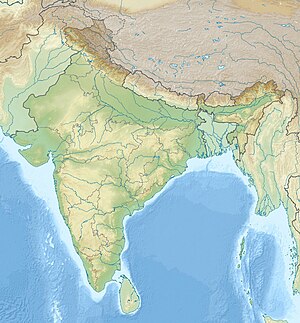Dudhkundi Airfield
This article includes a improve this article by introducing more precise citations. (September 2010) ) |
| Dudhkundi Airfield | |
|---|---|
| Part of Twentieth Air Force Tenth Air Force | |
| West Bengal, India | |
| Coordinates | 22°19′21.16″N 087°06′33.62″E / 22.3225444°N 87.1093389°E |
| Type | Military airfield |
| Site information | |
| Condition | Abandoned |
| Site history | |
| Built | 1942 |
| In use | 1942-1945 |
| Battles/wars | World War II |


Dudhkundi Airfield is an abandoned airfield in India, located 12 miles (19.2 km) SE of Jhargram, in the Jhargram district in the Indian state of West Bengal.
History
During
Dudhkundi was originally designed for
Finally ready for use in July 1944, the
However, all the supplies of fuel, bombs, and spares needed to support operations from Kwanghan had to be flown 1,200 miles from India over "
Missions of the 444th flown from Dudhkundi included attacking transportation centers, naval installations, aircraft plants, and other targets in
On the night August 10–11, 56 B-29s staged through British air bases in
In September 1944, the 679th Bomb Squadron was inactivated in order to streamline the group's organization. This left the 444th with three squadrons of ten B-29s each.
The 444th evacuated staging fields in China in January 1945 due to the Japanese offensive in South China which threatened the forward staging bases, but continued operations from India, bombing targets in Thailand and mining waters around Singapore. However, by late 1944 it was becoming apparent that B-29 operations against Japan staged out of the bases in Chengtu were far too expensive in men and materials and would have to be stopped. In December 1944, the Joint Chiefs of Staff made the decision that Operation Matterhorn would be phased out, and the B-29s would be moved to newly captured bases in the Marianas in the central Pacific.
On 1 March 1945, the 444th Bombardment Group flew south to Ceylon, then southeast across the
With the departure of the B-29s to the Marianas, Dudhkundi Airfield was turned over to the Tenth Air Force. The 87th Air Depot Group took over command of the airfield, and the mission of the base was to be a maintenance and disposition center for surplus Allied aircraft.
The
With its departure, the
With the last Americans leaving in early 1946, the airfield was turned over to the British colonial government.
Prior to
See also
References
![]() This article incorporates public domain material from the Air Force Historical Research Agency
This article incorporates public domain material from the Air Force Historical Research Agency
- Maurer, Maurer (1983). Air Force Combat Units Of World War II. Maxwell AFB, Alabama: Office of Air Force History. ISBN 0-89201-092-4.
- 444th Bomb Group Website






